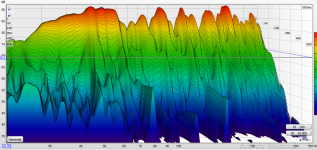I would advice to zoom in the waterfall between something like 20-350 Hz and use 5 dB increments...
even if it looks not so smooth, it sounds really good. And those two continue "blades" at 80 and 160Hz are just external noise from an UPS generator.
Attachments
Last edited:
Everything is relative. If you got rid of or minimized the resonances it would sound substantially better. But very few know how an almost "resonant free" system actually sound like.even if it looks not so smooth, it sounds really good. And those two continue "blades" at 80 and 160Hz are just external noise from an UPS generator.
A couple months ago Dr. Geddes gave this answer about LF treatment. I hope it is not too late for a further question.
We are used to see everywhere in the Web those ceiling traps built as framed rockwool panels, spaced from the actual ceiling and covered in fabric.
The same devices are seen also on walls.
I understand the need for wideband absorption at first reflection points but, apart of it, should them be replaced by drywall panels attached to resilient channels, as explained above ?
I mean a ceiling with flat drywall "islands" instead of hanging rockwool boxes.
It would be a very different approach.
Thanks
Understand that my technique is very good for LF absorption while not absorbing much at HFs. That was my intent. Absorption panels tend to work in the exact opposite manner, that's why I don't use them. Small rooms needs lots of LF absorption, but not at HFs since almost everything in the room is going to do that job already. In a fairly well sealed room the LFs will get out of hand unless there is some absorption.
That article makes a couple of references to filling in dips with EQ, sorry, that can't be done.
That depends on how deep the dip is. A shallow one is no problem, but a true null cannot be eq'd. A deep null could only occur if there were only two interfering sources exactly out of phase. If there are more sources, like I recommend, then deep nulls are virtually impossible to happen and hence the entire LF spectrum can be corrected for three sources.
Even in the modal region, moving the mic a few inches will make a big difference.
This is not actually true - in the modal region (you have it backwards.) It is true above that region, but in the modal region the sound does not change much from location to location. Far less than it does above the modal region.
Yes, but higher up the spectrum it isn't as noticeable. I can move a few inches in my room and a 50Hz dip comes and goes, I only have two subs though, three does seem the way to go out of all the options.
Correct. Are you suggesting a 50Hz tone is cancelling (or not) with the radiant mains field in my room?? 

Computers are noisy environments. I've had issues at that frequency. Depending on what I am doing, sometimes it will show high in magnitude, sometimes it will vary from shot to shot as if taking an instantaneous value within a cycle.
That article makes a couple of references to filling in dips with EQ, sorry, that can't be done.
If it isn't a room mode, it can.
//
- Status
- Not open for further replies.
- Home
- General Interest
- Room Acoustics & Mods
- Acoustics of corners
